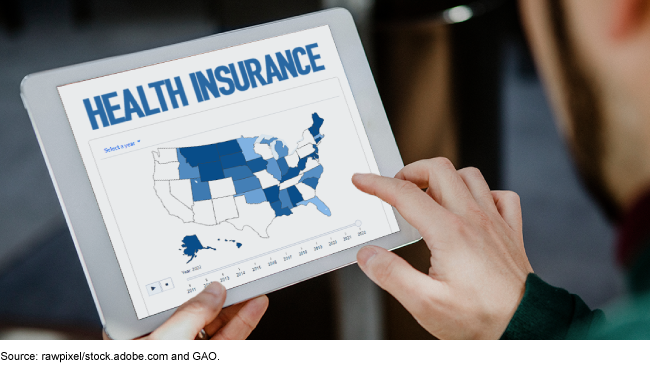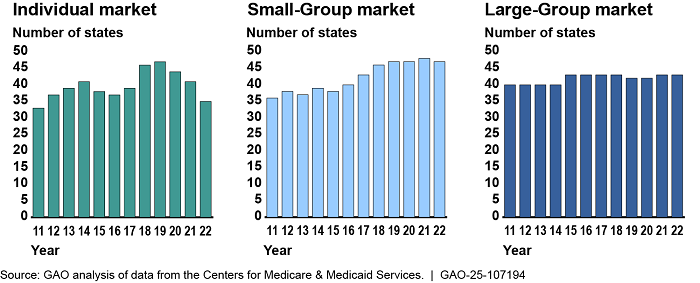Private Health Insurance: Market Concentration Generally Increased from 2011 through 2022
Fast Facts
Several companies may be selling health insurance in a given market, but, as we previously reported, most people usually enroll with one of a small number of insurers. Known as market concentration, this can result in fewer choices of insurers and higher premiums due to less competition in the market.
Market concentration generally increased from 2011 through 2022, with three or fewer insurers holding at least 80% of the market share for the individual and employer group markets in at least 35 states. However, the markets for individuals became slightly less concentrated from 2020 to 2022.

Highlights
What GAO Found
In November 2022, GAO reported that, from 2011 through 2020, enrollment in private health insurance plans was concentrated, meaning a small number of issuers of those plans enrolled most of the people in a given market (GAO-23-105672). Specifically, GAO considered a market concentrated in a state if three or fewer issuers held at least 80 percent of the market share of enrollment. For this report, GAO examined the individual (coverage primarily sold to individuals who lack access to group coverage), small-group (coverage offered by small employers), and large-group (coverage offered by large employers) health insurance markets from 2011 through 2022 and found that concentration generally increased. Specifically:
- The overall individual market became more concentrated from 2011 through 2022. Concentration in this market peaked in 2019 and became slightly less concentrated through 2022.
- The small-group market became more concentrated from 2011 through 2022, but the rate of increase slowed more recently.
- The large-group market remained concentrated with only slight increases from 2011 through 2022 (see figure).
Number of States, including the District of Columbia, Where the Three Largest Issuers Had at least 80 Percent of Enrollment, 2011 through 2022

GAO also examined concentration across the individual insurance exchanges, which are part of the overall individual market. Individual exchanges, which are marketplaces where consumers can compare and select among insurance plans offered by participating issuers, were established by the Patient Protection and Affordable Care Act (PPACA). Similar to the overall individual insurance market, the individual exchanges became more concentrated from 2015 through 2020 and then generally less concentrated through 2022. The number of states where the individual exchanges were concentrated increased from 47 states in 2015 to a peak of 51 states in 2020, and then decreased to 47 states in 2022.
We provided a draft of this report to the Department of Health and Human Services for review and comment. The department did not have any comments on the report.
Why GAO Did This Study
Private health insurance is the most common source of health insurance coverage in the United States. Individuals have various options for obtaining private health insurance, including through the individual, small-group, and large-group markets. A concentrated health insurance market may indicate less issuer competition and could affect consumers’ choices of issuers and the premiums they pay for insurance.
PPACA included a provision for GAO to periodically study health insurance market concentration. This report describes changes in the concentration of enrollment among issuers in the overall individual, small-group, and large-group health insurance markets and in the individual insurance exchanges.
GAO determined market share in each of the three overall markets and the individual insurance exchanges using enrollment data from 2011 through 2022 that issuers report to the Centers for Medicare & Medicaid Services and enrollment data that GAO collected from individual states from 2015 to 2017. For all analyses, GAO used the most recent data available at the time of its review.
For more information, contact John E. Dicken at (202) 512-7114 or dickenj@gao.gov.
